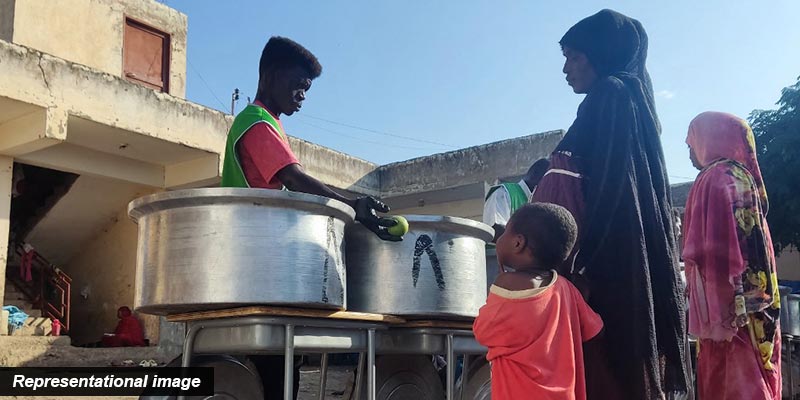- World
- Jun 17
UN report raises alarm over 13 ‘hunger hotspots’
• A new report by the World Food Programme (WFP) and the Food and Agriculture Organisation (FAO) projects a serious deterioration of acute food insecurity in 13 countries and territories — the world’s most critical hunger hotspots in the coming months.
• The semi-annual Hunger Hotspots report is an early-warning and predictive analysis of deteriorating food crises for the next five months.
• It warns that people in five hunger hotspots around the world face extreme hunger and risk of starvation and death in the coming months unless there is urgent humanitarian action and a coordinated international effort to de-escalate conflict, stem displacement, and mount an urgent full-scale aid response.
• The report shows that Sudan, Palestine, South Sudan, Haiti and Mali are hotspots of highest concern, with communities already facing famine, at risk of famine or confronted with catastrophic levels of acute food insecurity due to intensifying or persisting conflict, economic shocks, and natural hazards.
• In addition to hotspots of highest concern, Yemen, Congo, Myanmar and Nigeria are now hotspots of very high concern and require urgent attention to save lives and livelihoods. Other hotspots include Burkina Faso, Chad, Somalia, and Syria.
• Armed violence remains the primary driver of acute food insecurity in 12 of the 13 hotspots.
• In multiple hotspots, aid delivery is significantly hampered by restricted humanitarian access due to insecurity, bureaucratic impediments, or physical isolation.
• At the same time, critical funding shortfalls are forcing reductions in food rations, limiting the reach of life-saving nutrition and agricultural interventions.
• Beyond conflict and economic crises, weather extremes and increased climate variability are exacerbating acute food insecurity in many regions.
• The WFP and FAO are calling for the international community to drastically step up funding for food and nutrition related humanitarian aid in the coming months and advocate for an end to the fighting.
Hotspots of highest concern
1) In Sudan, famine was confirmed in 2024. Conditions are expected to persist due to the continuing conflict and ongoing displacement, particularly in the Greater Kordofan and Greater Darfur regions. Displacement is likely to increase further during the outlook period while humanitarian access remains restricted. The circumstances are driving the country towards the risk of partial economic collapse, with high inflation severely limiting food access. Around 24.6 million people were projected to face Crisis or worse (IPC Phase 3 or above) levels of acute food insecurity, including 637,000 people facing Catastrophe (IPC Phase 5) through May 2025.
2) In Palestine, the likelihood of famine in the Gaza Strip is growing as large-scale military operations hinder the ability to deliver vital food and non-food humanitarian assistance. In addition to the humanitarian crisis unfolding in the Gaza Strip, high food prices coupled with exhausted livelihoods and a commercial blockade will accelerate an economic collapse. The entire population in Gaza — 2.1 million people — is projected to face Crisis or worse (IPC Phase 3 or above) levels of acute food insecurity, with 470,000 projected to face Catastrophe (IPC Phase 5) through September 2025.
3) South Sudan faces compounding threats from political tensions, the risk of flooding, and economic challenges. Approximately 7.7 million people — or 57 per cent of the population — are projected to face high levels of acute food insecurity (IPC Phase 3 or above) between April and July 2025, with 63,000 people projected to face Catastrophe (IPC Phase 5) levels of acute food insecurity. An IPC update released after the report’s finalisation indicated Risk of Famine in two areas of the country and confirmed the bleak outlook.
4) In Haiti, record levels of gang violence and insecurity are displacing communities and crippling aid access. Over 8,400 internally displaced persons (IDPs) are already facing Catastrophe (IPC Phase 5) levels of acute food insecurity in the Port-au-Prince metropolitan area by June 2025.
5) In Mali, high grain prices and ongoing conflict are eroding the coping capacities of the most vulnerable households, particularly in conflict-affected areas. Around 2 600 people are at risk of Catastrophe (CH Phase 5) from June to August 2025 if assistance is not provided on time.
Additional hotspots and areas of improvement:
• Yemen, the Democratic Republic of the Congo, Myanmar and Nigeria are classified as hotspots of very high concern and require urgent attention to save lives and livelihoods and for preventing further deterioration.
• Other hotspots are Burkina Faso, Chad, Somalia and the Syrian Arab Republic.
• In Myanmar, the impact of the recent major earthquake is likely to worsen the already dire food insecurity situation in the country, driven by escalating conflict, widespread displacement, severe access restrictions and high food prices.
• Congo has been re-introduced to the hotspot list due to intensifying conflict.
• In contrast, Ethiopia, Kenya, Lebanon, Lesotho, Malawi, Mozambique, Namibia, Niger, Zambia, and Zimbabwe have been removed from the Hunger Hotspots list.
• In East and Southern Africa, as well as in Niger, better climatic conditions for harvests and fewer weather extremes have eased food security pressures. Lebanon has also been delisted following reduced intensity of military operations.
• However, FAO and WFP warn that these gains remain fragile and could reverse quickly if shocks re-emerge.
Manorama Yearbook app is now available on Google Play Store and iOS App Store

